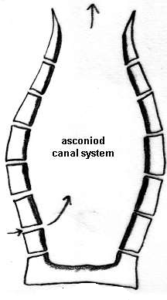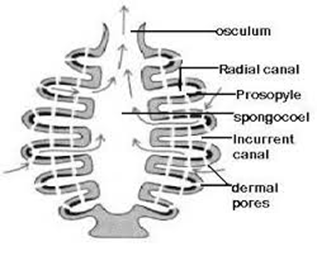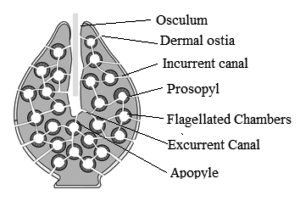Next phylum in the classification of the animal kingdom is phylum Porifera. Members of phylum Porifera are commonly known as sponges. They are the simplest pore-bearing and primitive multicellular organisms.
General Characteristics of Phylum Porifera:
Habitat:
They are aquatic generally marine (few species are found in freshwater). They are found solitary (live alone) as well as colonial (live in colonies) and sedimentary (attached to substratum or rock) forms.
Body Form:
The sponges may be cylindrical, vase-like, globular, flat or irregular.
Symmetry:
They are mostly asymmetrical. In some cases, radial symmetry can be observed.
Level of Organization:
They have a cellular level of organization without formation of tissues and organs.
Body surface:
The body surface is with numerous minute pores called ostia (singular: ostium) through which water enters the body.
Germ layers:
Sponges are diploblastic. The cells are arranged in two embryonic layers, external ectoderm, and an internal endoderm.
Body wall:
It is made up of two layers. The outer dermal layer called pinacoderm. It is formed by pinacocytes and porocytes. Porocytes are perforated by ostia. The inner gastral layer or choanoderm is formed by collar cells also called choanocytes. The two layers pinacoderm and choanoderm are separated by non-cellular layer mesohyal layer also called mesenchyme.
Body Cavity:
There is a large opening present at the free end called osculum. They show the presence of central space or paragastric cavity called spongocoel. They have a unique type of flagellated cells called choanocytes or collar cells for digestion. They line the spongocoel and the canals.
Canal System:
Sponges have a water transport or canal system. Water enters through minute pores (ostia) in the body wall into a central cavity, spongocoel, from where it goes out through the osculum. This pathway of water transport is helpful in food gathering, respiratory exchange and removal of waste.
Organs:
Digestive, respiratory and excretory organs are absent.
Skeleton:
Sponges have an exoskeleton of spicules of calcium carbonate or silica or proteinous sponging fibres. The spicules remain embedded in mesenchyme.
Mode of Nutrition:
They are filter feeders. Food particles are collected by choanocytes from the water current. Choanocytes and amoeboid cells help in intracellular digestion. They fed on detritus material (dead particulate organic matter) present in water.
Reproduction:
Sexes are
not separate (hermaphrodite), i.e., eggs and sperms are produced by the same
individual. Sponges reproduce asexually by budding, fragmentation and special
asexual reproductive bodies called gemmules.
They reproduce sexually by the formation of gametes. Fertilization is internal and development is indirect having an amphiblastula larval stage which is morphologically distinct from the adult. Larvae are free-swimming.
They have great power of regeneration. Even the isolated cells can reorganize into a complete sponge.
Examples:
Sycon (Scypha), Spongilla (Freshwater sponge) and Euspongia (Bath sponge).
Advanced Features of Phylum Porifera Over Protozoa:
- Large multicellular body.
- Cells have the division of labour
- Male and female gametes are differentiated into sperm and ova.
- Development of includes a larval stage-amphiblastula
Canal Systems in Phylum Porifera:
Different types of canal system shown in members of phylum Porifera are as follows:
Asconoid:
In sponges having asconoid canal system, the spongocoel is a large cavity.
The flow of water in asconoid canal system is Ingressing water → Ostia → Spongocoel → Osculum → Outside

Syconoid:
In sponges having syconoid canal system, the spongocoel is narrow non-flagellated cavity lined by pinacocytes. This canal system is formed due to folding on body wall compared to astonoid canal system.
The flow of water in asconoid canal system is Ingressing water → Dermal ostia → Incurrent canals → Prosopyles →Radial canals → Apopyles → Spongocoel → Osculum → Outside

Leuconoid:
In sponges having leuconoid canal system, the spongocoel is very narrow. This canal system is formed due to further folding on body wall w.r.t. syconoid canal system. Due to the complexity of canal system, radial symmetry is lost.
The flow of water in asconoid canal system is Ingressing water → Dermal ostia → Incurrent canals → Prosopyles → Flagellated chamber → Apopyles → Excurrent canals → Osculum → Outside

Rhagonoid:
In sponges showing rhagon type canal system, the body is conical with osculum situated at the top. The spongocoel is lined by oval flagellated chambers, opening into it by wide apopyles.
The rhagon type is a little complex than the complex syconoid type and is found in the larval stage of Demospongiae.
The flow of water in asconoid canal system is Ingressing water → Dermal ostia → Prosopyles → Flagellated chamber → Apopyles → Sponocoael → Osculum → Outside

Mechanism of current production:
There are two conditions of incurrent and excurrent. For entering water through dermal ostia into the body there must be a pressure inside the central cavity must be less than that in the incurrent canals. For escaping water through osculum The pressure within cavity must be higher than that in the excurrent canals. But as the pressure in the incurrent and excurrent canals is the same.
But the pressure at the periphery of the cavity should be less but at the opening (osculum) it should be more. Such a distribution of pressure is set up when each flagellum causes a flow of water towards the centre of the chamber.
Functions of the Canal System:
The canal system serves the purpose of nutrition. The canal system acts as a path for the food through the body cells. Water flows into the central cavity or spongocoel. Robert Grant observed that along with ingressed water smaller food-particles e.g. diatoms, protozoa and particles of organic debris are absorbed in spongocoel. The food is ingested into the cell’s protoplasm and digested. The digestion is intracellular. The canal system does the same functions as the circulatory system in higher animals.
The ingressed water has dissolved air, therefore, gaseous exchange or respiration takes place in the cells. Oxygen is taken in by the simple process of diffusion and carbon-dioxide is given out. The respiration is intracellular. The canal system does the same functions as the respiratory system in higher animals.
The outgoing water, which passes outside the osculum remove the excretory products like carbonic acid and other nitrogenous waste, The canal system does the same functions as the excretory system in higher animals.
The purpose of the canal system increases the surface area of the animal in the water.
Common Examples of Phylum Porifera:
Leucosolenia:

Within the phylum Porifera, there is a genus of calcareous (i.e., made of calcium carbonate), branched sponges called Luecosolenia. They are the simplest colonial sponges look like little bunches of bananas and most can be found attached to hard substrates in tide pools (shallow water and rocky seashore). An individual is tiny and of cylindrical shape. The base of the individual is attached to a substrate via a small adhesive disc, and individuals can attach to one another through horizontal stolons.
The external wall of Leucosolenia is made up of a single layer of scaly, flat cells called pinacocytes. There are pores within this wall called ostia that allow water to flow into the sponge, into a cavity called spongocoel. It has Asconoid canal system. Reproduction is both asexual and sexual.
Scypha (Sycon):

Scypha, also known as a crown sponge, is a small, shallow marine sponge found attached by a sticky secretion to some submerged solid object like rocks, shells of molluscs and corals. It has a perforated wall with folding on it. The body wall is thick with incurrent canals and flagellated chambers. The central space spongocoel is narrow. It has terminal osculum. It has syconoid canal system. Reproduction is both asexual and sexual.
Euplectella:

It is also known as Venus-flower basket. It is found at the bottom of sea attached to the floor by spicules present as a bunch at the base. The body is tubular, curved and basket-like and is made supported by six-rayed siliceous spicules. The body is very thick and the osculum is covered over by a sieve plate. A dry skeleton is shining white and is presented in marriages in Japan as a gift to show a permanent association between the couples. It is also used for drawing-room decorations. Canal system syconoid type. Reproduction is both asexual and sexual.
Euspongia:

It is a marine sponge commonly found in warm and shallow water attached to the substratum. It has commercial value. The skeleton is made up of spongin fibres without spicules. It is usually of globular shape with numerous oscula. Its dried skeleton is commonly used as bath sponges and for cleaning and washing.
Spongilla:

It is a freshwater sponge and is found usually attached to sticks or pieces of wood in lakes and ponds. Usually, it is yellowish-brown in colour and comprised of numerous small individuals with a common flat base. Due to the symbiotic relationship with algae zoochlorellae, the colony shows shades of green colour. The colony is irregularly branched have siliceous spicules and spongin fibres. Canal system is of rhagon type. To overcome the unfavourable period of desiccation freshwater sponges produce asexual bodies called gemmules.
One reply on “Phylum Porifera”
This is too good for all biology student